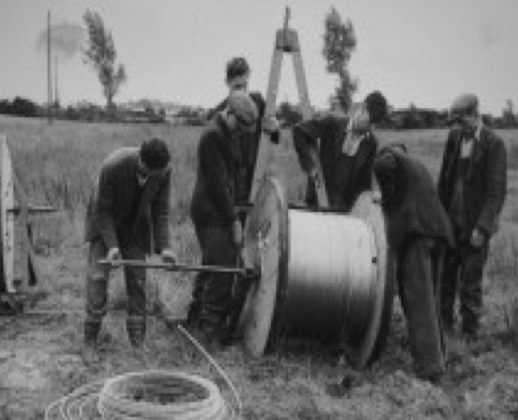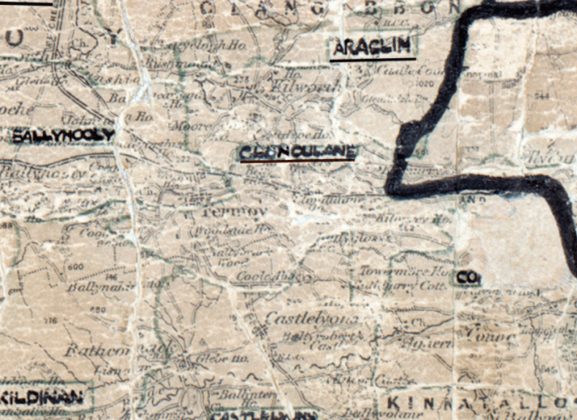By J.J. Bunyan
Sixty years have passed since the Rural Electrification Scheme was completed to deliver light and power to homes in Clondulane near Fermoy.
Many parts of Cork had electricity before the establishment of ESB in 1927. The ESB’s annual reports record 20 local electricity suppliers in the county — that means 20 individuals or companies who had permits to commercially supply electricity to 3 or more homes and businesses in their local area.
Clondulane Area was one of 92 designated rural areas in County Cork. Rural Electrification started there in August 1954, finished in April 1955 with a total of 1,135 poles used over a line amounting to 105 kilometres. In all, 125 premises were connected.
Sean Lemass TD, Minister for Commerce opened the debate in Seanad Eireann on March 7, 1945 exactly two months before World War II ended. The following were his prophetic words.
“I hope to see the day when a girl will enquire about the number of electrical appliances in the home rather than the number of cows he is milking or the number of churns of milk going to the creamery when she receives a proposal of marriage from a farmer”
Lemass confirmed the job of the magnitude of The Rural Electrification Scheme had never been undertaken. It would require in excess of one million wooden poles and involve the use of 75,000 miles of new line (compared to 2,000 miles of existing line), the erection of 100,000 additional distribution transformers (compared to 1,200 existing ones) and the connection of 250,000 existing urban customers.
In those bygone days of an almost forgotten era, the simple fact was people were surviving quite happily by using other sources of energy. They could have easily continued using candlesticks and oil lamps rather than electric light and power; open hearth turf fires and ranges rather than electric heaters, cheap wash boards and woman muscle power rather than electric washing machines. Domestic refrigerators were deemed as outrageous luxuries and best confined to Hollywood films.
In 1948/49, the mould of traditional rural life was broken by the introduction of rural electrification. It was met with the usual resistance in rural communities throughout Ireland. The principal objection was the cost factor. The “ground rent” element of the cost stirred up deep rooted historical memories of the detested landlords’ rack rent. People did not want another rent around their necks.
Many households felt it was a luxury they could not afford. It was a daunting change in lifestyle for old age pensioners with no other source of income. They were in their twilight years and they were being asked to part with the soft homely glow of the oil lamp and the flickering candle.
With their meagre pensions, they could not afford the cost of electric appliances. During their lifetime, the open turf fire in the hearth provided them with warmth was never allowed to go out. Now they were advised to replace it with an electric fire?
Small farmers with uncertain incomes saw no merit in signing up to connect to a network to provide electric light and power.
The route to rural electrification in rural parishes throughout Ireland was a thorny one for those with responsibility for its delivery. The debate on the merits of electric light and power raged at street corners, at church gates after mass, in creamery queues and in public houses.
Local clergy joined in the debate as part of the parochial duties. They did much to remove the unreasonable uncertainty and irrational fears, which permeated the debate.
The work of construction couldn’t begin the latter half of 1946. This was a consequence of post World War II shortages and the difficulty of sourcing supplies of suitable wooden poles in advance of commencing such a monumental task.
The newly created Electricity Supply Board (ESB) had divided the country into 792 areas – each served by an Engineer, an Organiser, A Clerk and a Supervisor. The first two were crucial to selling the scheme to households and had to ensure home owners kept their promise after they had 'signed up to be connected'.
As each area was canvassed, the line crews moved in to survey and peg the routes for the main lines. The day of reckoning had arrived. Home owners were faced of identifying a contractor to wire their homes or of opting out of connection to the scheme. The majority opted to sign the contract agreement .
Digging holes for the electricity poles was a major task in the days before the emergence of the JCB digger. They were dug by pick and shovel and men had very different experiences. The recruitment of local men to supplement the ESB crew was welcomed by the local community.
The members of ESB crews experienced traditional rural hospitality of home owners into Fermoy and Clondulane. At the end of a hard day’s work, ESB men and locals joined together in jovial conviviality in the local public houses.
The younger members of ESB attended dances in local halls and danced with local girls whom they had met in the course of their work.
Men diggings holes could get an trouble-free job if the soil was sandy or soft. Rock caused a lot of problems for them. The hole was quite wide and was six feet deep.
To get down that depth with a pick and shovel, a hole had to measure seven feet long, four feet wide at one end and tapering to a narrower width at the other end. There was a shelf at about four feet down and this reduced the amount of soil to be dug in the lower section.
The poles were pulled by a horse to individual holes. Teams of men slowly placed the pole in the hole and ensured it was perpendicular in a carefully coordinated effort.
The poles were imported mainly from Finland. The initial cost was £2 per pole. A total of 114,000 were shipped in 1947 and in all 1,000,000 arrived in the following years. They were shipped between May and September into Dublin, Cork and Limerick ports. Cresotting plants were established to treat them before poles were distributed to individual areas.
The term ‘backsliders’ was used to describe persons that had ‘signed up for connection’ in the initial canvass and later changed their minds. Many were the victim of an overzealous canvass by a local person of influence who had persuaded reluctant home owners to sign up in order to increase the numbers and improve the chances of getting electricity to their area at an earlier date. Refusals resulted from learning of the cost of wiring the house/premises and amount of the ground rent.
Obviously, the Rural Electrification Scheme had to be paid for – ESB achieved this through a two-part electricity tariff system in addition to a Government subsidy. One element was the fixed charge; this was known as ‘ground rent’. It was based on the floor area of the house and out buildings.
It was used to pay for the connection of the supply and appeared an unreasonable imposition to many consumers/customers. The second part was a unit charge for electricity actually used.
The physical work of rural electrification was almost done – the poles were up, the line was laid, and more and more premises in the area were being connected every day. But the success of the scheme depended on more than just the ‘switch on’ of the lights.
The following is an apocryphal story which did the rounds in the early 1950s. It illustrates the conservative attitude of many users and potential users towards the new power source. An elderly woman had her house wired but insisted there was to be no sockets in the walls because she could not afford any of these new-fangled appliances.
She also insisted that there was to be only one light socket in her house and that this socket was to hold the lowest wattage bulb available because she had visions of ending up in prison through not being able to pay the bill. After some months, the meter-reader called and he was very puzzled by the meter reading which was almost nil.
"You don't make much use of the electric light, Mam", he commented politely. "Oh, faith and then, I do, Sir" replied the old woman. "In the evening times, always I switch it on while I am searching for the candle".
It was essential that the new customers should not only be shown how to make the best use of the new power but should be actively encouraged to do so. With this in mind ESB undertook a widespread programme of education, demonstration and promotion. It focussed on the benefits of electricity both at home and on the farm.
In the homes of rural Ireland, the change from the soft glow of an oil lamp to the much harsher light of the electric bulb was a big one. Low watt bulbs were often preferred, to minimise both the contrast with the familiar oil lamp and the perceived high cost of electricity.
It is difficult nowadays for people to understand why anyone would refuse an essential household commodity like electricity.
By 1976, 420,000 households, representing 98/99% of all rural houses had been connected to the Rural Electrification Scheme at a total cost of £80 million. The State subsidy amounted to £28 million.
– Images courtesy of ESB Archives at www.esbarchives.ie











